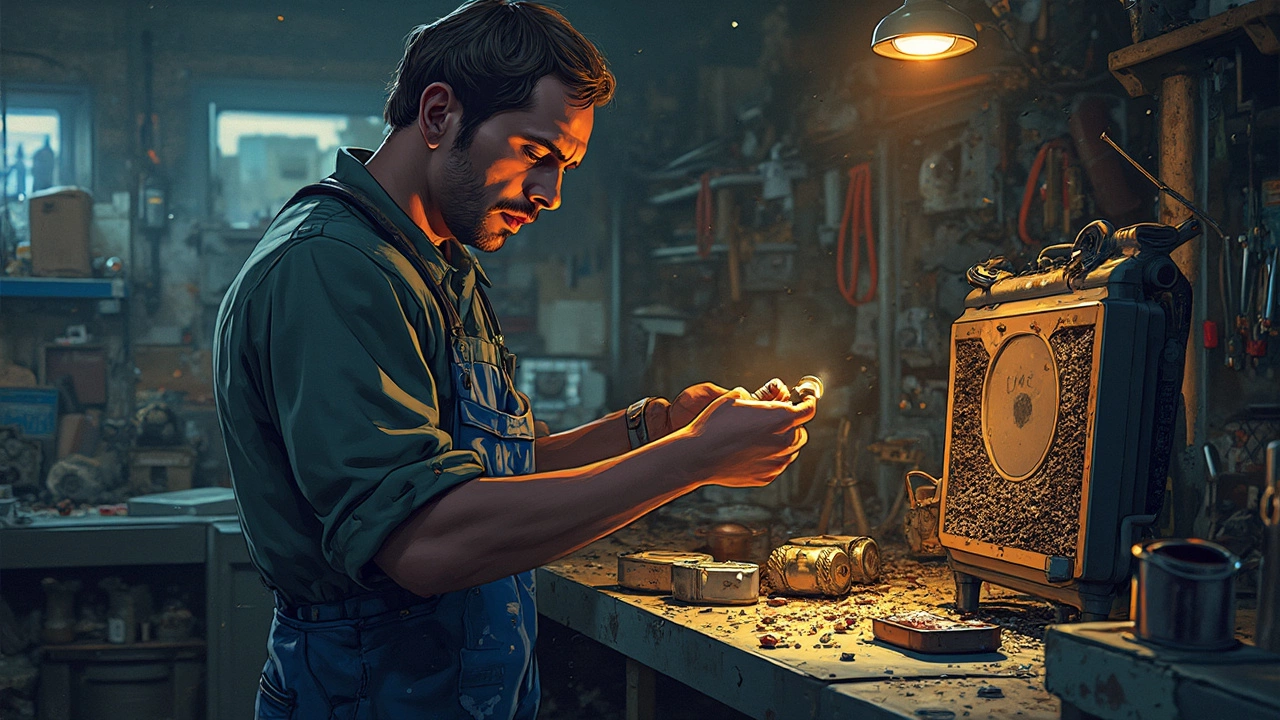Car radiators might not be the first thing you think about until your engine is overheating on the side of the freeway. Radiator failure is not just a nuisance; it can lead to serious engine damage if not addressed in time. And trust me, no one enjoys being stranded because of radiator issues.
The radiator's job is to keep the engine cool by circulating coolant. But when things go wrong, leaks, clogs, and rust are usually to blame. A leaky radiator, for instance, can quickly deplete the coolant levels, causing overheating. Regular checks for puddles under your vehicle can be a lifesaver when it comes to spotting leaks early.
Clogs are another sneaky culprit, often caused by debris or mineral deposits building up over time. These blockages restrict the flow of coolant, and the first sign could be an engine running hotter than usual. Flushing the system regularly can help keep this problem at bay.
- Introduction to Radiator Function
- Common Cause: Leaks
- The Perils of Clogging
- Rust: The Silent Killer
- Prevention and Maintenance Tips
- When to Seek Professional Help
Introduction to Radiator Function
So, you’ve probably heard that your car’s radiator is crucial, but do you know why it’s such a big deal? Simply put, the radiator is your car’s personal cooling system. It helps regulate engine temperature so that things don’t get too hot to handle. Without this essential part, your engine would literally burn itself up in no time.
How does it work, you ask? A car radiator basically acts like a heat exchanger. Here's the scoop: your engine generates heat while running—lots of it. The radiator cools things down by circulating a liquid coolant through the engine block, picking up heat along the way. After picking up heat, this hot coolant gets directed to the radiator, where it is cooled by air flowing over the radiator’s surface as you drive. This cooler fluid then cycles back to the engine, repeating the process.
Why Cooling is Essential
Overheating can spell disaster for an engine. Metal parts of the engine could warp or fail, leading to massive repair bills or, even worse, needing a full engine replacement. A successfully working radiator keeps everything at the right temperature, ensuring a longer life for your vehicle.
Key Components of a Radiator
- Core: The central part, consisting of metal fins that increase the surface area for heat dissipation.
- Pressure Cap: Maintains proper pressure in the cooling system, which raises the boiling point of the coolant.
- Hoses: These carry coolant to and from the engine to the radiator.
Did you know that a typical car radiator needs to maintain engine temperatures between 195°F and 220°F? Keeping the system in this range is critical for performance and safety.
So next time you pop your hood, give your radiator a nod of respect. It’s working hard so you can enjoy a smooth and hassle-free drive.
Common Cause: Leaks
If your car is leaving little puddles behind, it might be more than just a bit of water. Leaks are one of the most common causes of radiator failure and can spell trouble if left unchecked. These leaks usually happen at the hose connections or splits in the radiator itself. It's crucial to catch them early to avoid bigger issues.
Identifying Leaks
Spotting a leak isn't rocket science, but it requires a keen eye. Check under your car regularly for any colored fluid. Coolant typically comes in a bright green, orange or pink. If you see any of these, it’s time to pop the hood.
How Leaks Develop
Leaks might seem minor, but they can escalate quickly. They often start due to weak points in the radiator hoses or a worn-out radiator cap. Another common cause is corrosion. Given time and exposure to contaminants, rust can eat away at the radiator, causing it to develop holes or cracks.
Making sure your radiator cap is on tight and replacing worn hoses can make a big difference in avoiding leaks. Also, flushing the coolant system during regular maintenance can help prevent buildup that leads to rust.
Tackling Leaks
If you suspect a leak, a quick pressure test can confirm it. This involves attaching a pressure tester to the radiator and checking for any drops in pressure, which indicate leaking spots. Now, unless you're handy with tools, it's often best to leave the actual repair work to a professional. But understanding where and why leaks occur can help save you a lot of headaches.
| Visual Cue | What It Could Mean |
|---|---|
| Puddles underneath car | Potential coolant leak |
| Frequent overheating | Coolant loss due to leak |
| Low coolant indicator | Radiator leak possibly |
No one wants to deal with car radiator issues unexpectedly. But having a little knowledge about leaks can help you keep your radiator in shape. A bit of preventive maintenance and attention can go a long way in avoiding those roadside breakdowns.
The Perils of Clogging
Clogging in a car's radiator is like cholesterol in arteries—it's all about the flow, or lack of it. When we talk about clogged radiators, it usually means something is obstructing the normal flow of coolant, and that can't be good for anyone.
One of the most common reasons for clogging is build-up from debris or mineral deposits. You know those little bits of leaves and grime that sneak into every nook and cranny of your car? They sometimes find their way into the radiator, forming unwanted barriers over time. And don't even get me started on mineral deposits! Hard water—full of minerals—can leave its mark too, creating layers of scale that gum up the works.
Identifying Clogs
Recognizing a clog isn't always straightforward, but a few signs can tip you off. If your engine starts to overheat regularly, or you're noticing fluctuations in temperature more than usual, these could be red flags. Another telltale sign? Less heat in your cabin when you turn the heater on full blast. Yeah, that's right—your cozy car warming system can also give clues if something's off with the radiator.
Combating Clogs
Tackling clogs isn't rocket science, but it requires consistency. One of the easiest things you can do is ensure the coolant is clean and at the right levels. Regular flushing of the radiator can clear out deposits and debris before they become a bigger problem. It's not just about adding new coolant—removing the old stuff is critical to prevent build-up.
- Check and refill coolant as needed
- Flush the radiator annually
- Inspect for signs of buildup
The Big Picture
Keeping your radiator clean might seem trivial, but ignoring it can lead to more serious radiator problems—and who wants that? You know what they say: prevention is better than cure. Consider these steps as basic car care to avoid bigger headaches down the road.

Rust: The Silent Killer
You might not think twice about rust, but when it comes to your car radiator, it can be a game-changer. Rust is sneaky—it creeps into your system and weakens it from the inside out. And often, by the time you notice, damage has already set in.
So how does rust make its way into your radiator? Well, it usually starts with the coolant. Over time, and especially if not replaced regularly, the coolant can lose its anti-corrosive properties. As the coolant breaks down, rust starts to form and can cause those dreaded radiator leaks.
Signs of Rust Trouble
Spotting rust isn't always easy since it works beneath the surface. But there are signs to look for. If your radiator fluid looks brown or muddy, that’s a major red flag. Also, keep an ear out for any rattling noises, as flakes breaking off the rust can get stuck and cause a racket.
Preventing and Addressing Rust
Prevention is always better than cure, right? Start with regular maintenance. Flushing the system every two years is a good bet. It helps get rid of any rust build-up and keeps your radiator in top shape. Replace your coolant according to the manufacturer's recommendation as this ensures that the system remains corrosive-free.
- Regularly check your coolant for any discoloration.
- Keep an eye on your temperature gauge; any unusual readings might mean corrosion.
- Inspect your radiator for any visible signs of rust or corrosion.
And hey, if you're not handy with car repairs, don't hesitate to get professional help. A trusted mechanic can diagnose issues and suggest fixes you might overlook.
Prevention and Maintenance Tips
Taking care of your car's radiator doesn't have to be a hassle. A few simple practices can keep your radiator from failing at the worst possible moment. Let's get into some easy tips you can do yourself.
Regular Coolant Check
First things first, always ensure that your car has enough coolant. Your car radiator relies heavily on this fluid to regulate engine temperature. Check the coolant levels every month, especially during extreme weather conditions. If it’s low, top it off with the right type for your vehicle model.
Schedule Regular Flushing
Flushing out the cooling system every couple of years prevents the build-up of debris and mineral deposits. A clean radiator is less prone to clogs, keeping your car functioning smoothly. You can do this yourself or have a professional handle it during other routine services.
Check for Rust and Leaks
Rust is a big enemy of radiators, weakening metal and leading to leaks. Once a year, take a good look at your radiator's exterior for any signs of rust, corrosion, or wet spots that indicate leaks. Catching these early can save you a lot of trouble down the road.
Keep the Radiator Cap in Check
The radiator cap serves a crucial purpose, keeping the coolant under pressure. A faulty cap can lead to coolant loss and overheating. Make sure the cap fits properly and doesn’t show signs of wear or cracks. Investing in a high-quality cap is a small cost for a big return.
Mind the Temperature Gauge
Don't ignore your dashboard's temperature gauge. If it starts to rise more than usual, it might be time to investigate. This early warning sign is your chance to prevent a more significant problem.
Professional Inspection
Sometimes things happen beyond what DIY can fix. It’s wise to have a mechanic check your radiator during regular car maintenance appointments to catch unseen issues before they escalate.
When to Seek Professional Help
So, you've tried everything you can with your car's radiator, and it's still acting up. When should you throw in the towel and call a pro? If you're not exactly a gearhead, it might be sooner than you think. No shame in getting some expert help to save your ride.
Radiator leaks are often manageable with a bit of patchwork, but when the leak looks like a mini Niagara Falls, it might be time to let a professional handle it. A small leak can suddenly expand into something much worse, causing engine damage and hefty repair bills. A mechanic will have the tools to perfectly seal any breach.
Persistent Overheating
If your engine's been getting hot under the hood more often than a telenovela character, and you've exhausted your own tricks, a specialist might find deeper issues. Overheating could signal severe problems like a clogged radiator, busted thermostat, or cooling fan failure—all of which require a professional touch.
Strange Noises
Ever heard your car make noises akin to a haunted house? Clicking, hissing, or popping sounds from under the hood might not just be annoying; they could indicate radiator or cooling system issues. Often, these sounds point to air bubbles or a misaligned fan—another case where professional expertise becomes necessary.
In essence, if your DIY fixes aren't doing the trick, or if you're unsure about a sudden change in your car's behavior, play it safe and get in touch with a pro. Car radiator failure is no joke and dealing with it sooner rather than later can save your engine—and your wallet—a lot of grief.






